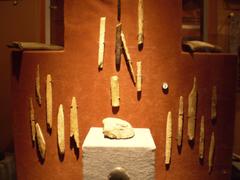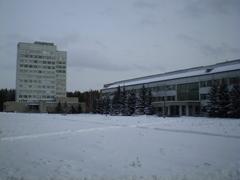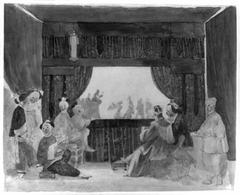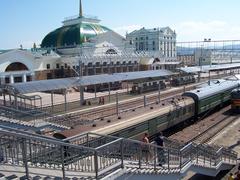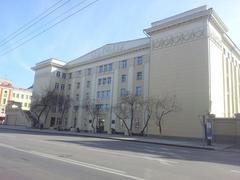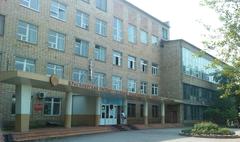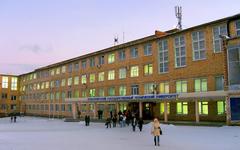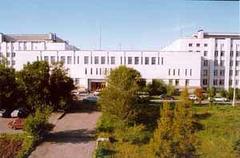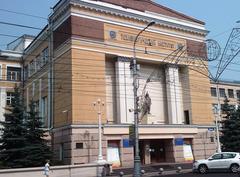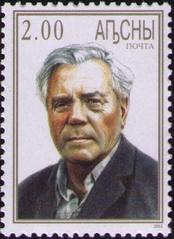
Krasnoyarsk Bridge Visiting Hours, Tickets, and Travel Guide
Date: 04/07/2025
Introduction
The Krasnoyarsk Bridge is a symbol of Siberian ingenuity, historical transformation, and architectural achievement. Spanning the Yenisei River in the heart of Krasnoyarsk, this iconic structure has played a pivotal role in the city’s evolution from a remote outpost to a thriving industrial and cultural hub. Initially constructed as part of the Trans-Siberian Railway in 1896 under the leadership of engineer Lavr Proskuryakov, the bridge helped link European Russia to the Far East, catalyzing economic growth and regional integration.
Though the original railway bridge is now reserved for rail traffic, adjacent structures such as the Komunalny (Communal) Bridge—built in 1956—now serve both vehicular and pedestrian traffic, offering accessible routes and panoramic views of the Yenisei and city skyline. The bridges’ cultural and historical significance is celebrated in local festivals, art, and even Russian currency, making them must-see landmarks for travelers. Plan your visit with up-to-date resources such as RBTH, Miss Tourist, and dedicated travel apps for the best experience.
Table of Contents
- Early Foundations and the City’s Growth
- Design and Construction of the Krasnoyarsk Bridge
- Engineering Achievements and International Recognition
- The Bridge’s Role in Urban Development
- The Komunalny Bridge: Modern Connectivity
- Visiting Hours, Tickets, and Accessibility
- Guided Tours and Events
- Travel Tips and Nearby Attractions
- Cultural Importance and Symbolism
- Preservation and Modern Recognition
- Frequently Asked Questions (FAQ)
- Practical Visitor Information
- Summary and Recommendations
- Sources
Early Foundations and the City’s Growth
Established in 1628 as a Cossack outpost, Krasnoyarsk grew into a strategic river port and trade center due to its favorable position on the Yenisei River. The arrival of the Trans-Siberian Railway in 1895 marked a turning point, setting the stage for the construction of the Krasnoyarsk Bridge and transforming the city into a gateway between European Russia and Siberia (RBTH).
Design and Construction of the Krasnoyarsk Bridge
The original Krasnoyarsk Railway Bridge, completed in 1896, was the result of innovative engineering to overcome the Yenisei’s formidable width and flow. Designed by Lavr Proskuryakov, its steel truss structure stretched 907 meters, making it one of the longest bridges in Russia at the time. Advanced construction methods, including caisson foundations and large steel arches, were used to ensure stability and durability in Siberia’s harsh climate (RBTH).
Engineering Achievements and International Recognition
The bridge was heralded for its advanced parabolic trusses and robust design, earning a gold medal at the 1900 Exposition Universelle in Paris. Its depiction on the Russian 10-ruble banknote further cemented its status as a national icon (Miss Tourist). Though the original structure was eventually dismantled, its legacy endures in the city’s cultural memory and urban landscape.
The Bridge’s Role in Urban Development
By facilitating seamless east-west rail travel, the bridge was instrumental in Krasnoyarsk’s transformation into an industrial powerhouse. During the Soviet era, factories and population centers flourished on both banks of the Yenisei, thanks in part to the reliable transit provided by the bridge (RBTH). The bridge also played a strategic role during World War II, supporting the movement of resources and people across Siberia.
The Komunalny Bridge: Modern Connectivity
The Komunalny (Communal) Bridge, completed in 1956, is a vital modern link for vehicles and pedestrians. At over 2,300 meters, it was the longest bridge in Asia at the time and exemplifies Soviet-era engineering with its sweeping concrete arches and integration into the city’s urban plan. Its elegant form and vibrant lighting have made it a contemporary symbol of Krasnoyarsk, featured in numerous photographs and city celebrations (Miss Tourist).
Visiting Hours, Tickets, and Accessibility
- Viewing Hours: The railway bridge is reserved for trains and not open to pedestrians. However, the Yenisei embankment and the pedestrian paths on the Komunalny Bridge are accessible daily from dawn to dusk (typically 6:00 AM to 10:00 PM).
- Tickets: Access to the embankment and pedestrian bridges is free. Guided walking tours and river cruises, which offer enhanced experiences and historical context, require tickets (500–1000 RUB for tours; river cruise prices vary).
- Accessibility: The embankment and Komunalny Bridge have ramps, smooth paths, and accessible facilities for wheelchair users and strollers.
Guided Tours and Events
Local operators offer historical walking tours in multiple languages and river cruises that provide unique perspectives of the bridge and city skyline. Annual events—such as Krasnoyarsk City Day and the Winter Ice Festival—feature the bridges in light shows, concerts, and public art displays. Booking guided tours in advance is recommended during peak travel months.
Travel Tips and Nearby Attractions
- Best Views: Yenisei Embankment and Karaulnaya Hill for panoramic photos; Tatyshev Island for recreational activities and unique angles.
- Nearby Sights: Krasnoyarsk Regional Museum, Surikov Art Museum, and city center landmarks are within easy reach.
- Amenities: Cafes, souvenir shops, and parks line the embankment for relaxed visits.
- Transport: Reliable buses, trams, and taxis connect major sites. The city is also accessible from Yemelyanovo International Airport.
Cultural Importance and Symbolism
The bridges are deeply embedded in Krasnoyarsk’s identity, symbolizing resilience, progress, and unity. They appear in art, literature, and on the 10-ruble note, and serve as central venues for city festivals and social gatherings (Miss Tourist). The Yenisei embankment is a lively meeting place year-round, especially during public celebrations.
Preservation and Modern Recognition
Efforts continue to maintain the original bridge’s legacy as a monument to Russian engineering, even as newer structures take on daily transport duties. The Komunalny Bridge is regularly updated with modern lighting and safety features, earning accolades like the LIT Lighting Design Award (LIT Awards).
Frequently Asked Questions (FAQ)
Q: What are the Krasnoyarsk Bridge visiting hours?
A: Public embankments and the Komunalny pedestrian bridge are open daily from approximately 6:00 AM to 10:00 PM.
Q: Do I need tickets to visit or view the bridges?
A: No tickets are required for public areas. Tickets are only needed for guided tours or river cruises.
Q: Is the bridge accessible to wheelchairs?
A: Yes, modern embankments and the Komunalny Bridge have accessible paths and ramps.
Q: Can I walk on the original railway bridge?
A: No, the railway bridge is not open to pedestrians. Use the Komunalny Bridge or designated embankment viewing areas.
Q: Are English-language tours available?
A: Yes, many local operators offer tours in English and other languages.
Practical Visitor Information
- Weather: Visit between May and September for mild temperatures (15–28°C). Winter visits (down to -30°C) offer dramatic, snowy views but require warm clothing.
- Safety: Krasnoyarsk is generally safe, but remain on marked paths and be mindful near the river and traffic.
- Etiquette: Respect local customs, avoid loud noise, and seek permission before photographing locals, especially near religious sites.
- Sustainability: Dispose of litter responsibly and support local businesses to help preserve the area’s heritage.
Summary and Recommendations
Krasnoyarsk’s bridges are much more than infrastructural achievements—they are enduring testaments to Russian innovation, Siberian spirit, and the city’s ongoing transformation. From the historic railway bridge that opened Siberia to the world, to the sweeping arches of the Komunalny Bridge, these landmarks offer unforgettable experiences to visitors. Maximize your visit by exploring the embankment, joining a guided tour, or attending a festival, and capture the beauty of these structures against the city’s dramatic landscape.
For up-to-date travel tips, downloadable maps, and exclusive content, download the Audiala app, and consult trusted guides such as RBTH and Miss Tourist.
Sources
- Krasnoyarsk Bridge: Visiting Hours, Tickets, and Historical Overview of Krasnoyarsk’s Iconic Bridges, 2025, RBTH
- Krasnoyarsk Krai, Russia Itinerary, Miss Tourist
- LIT Lighting Design Award Winners, 2025
- Krasnoyarsk, Russia: What to Visit, Wild Trips
- Trans-Siberian Railway History
- Krasnoyarsk City Events
- The Invisible Tourist’s Russia Travel Tips
For more information, guides, and exclusive travel content, download the Audiala app and follow us on social media.











